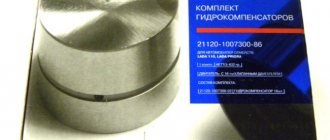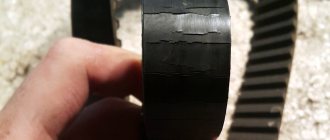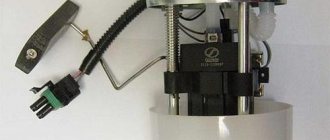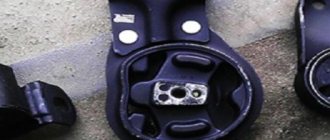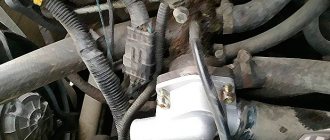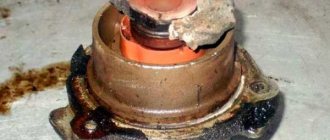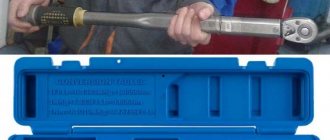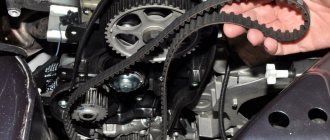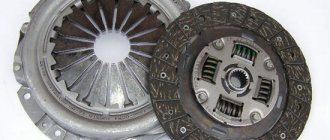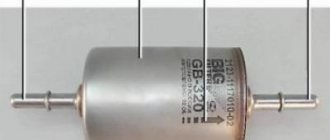Hydraulic compressors, or hydraulic valve pushers as they are also called, are designed to automatically adjust their thermal clearances. Simply put, they are a kind of gaskets between the camshaft cams and valves, capable of changing their thickness. The hydraulic compensator consists of a cylindrical body, as well as a special plunger consisting of a bushing, a spring and a ball valve. Their use on the VAZ-2112 engine makes it possible not to periodically check thermal clearances, as on the 2108 engine (valve adjustment) .
The replacement of hydraulic compensators is described and shown in detail and “up close” in the video below:
What to do if valves or hydraulic compensators on a VAZ 2112 16 valves are knocking?
Few drivers know what to do if valves or hydraulic compensators on a VAZ 2112 16 valves are knocking. This is a fairly common situation. But most people do not know the reasons for such phenomena and are afraid of them. In fact, this may be quite common and should not be a cause for concern. Depending on the characteristics of the knock, we can draw a conclusion about its nature and danger to the engine. Some types of knocking are quite harmless. You can ride with them, but this problem may lead to others. Therefore, it is still better to eliminate the cause immediately. Moreover, in most cases this does not require any special costs.
Typical faults
Before examining the removed hydraulic compensator, you need to identify the non-functioning element. Compensators are located on the valves, so their number is equal to the number of valves provided on the engine.
The check can be done without removing the camshaft. But first you need to understand why even new elements fail. There are 4 main faults.
- The gap provided between the plunger itself and its bushing increases. As a result, oil will begin to leak. The compensator will not be able, so to speak, to select thermal gaps;
- The valve does not close properly. This happens rarely, but it should not be ruled out. Because of this, the required pressure cannot be created between the plunger and the bushing;
- Jamming of the plunger pair. The way the sleeve works is that it should move freely relative to the installed plunger. If this freedom is not there, hello jamming;
- Blockages. Oil channels become dirty. Therefore, hydraulic compensators (HC) cannot work.
There is a fairly extensive list of video and photo guides that you can use to check.
It is important for the motorist to tell which of the existing main engines is knocking in order to repair it, replace it and restore normal engine operation
It is worth noting that some cars do not have hydraulic compensators. So a slightly different technology is provided.
Most often, motorists ask such questions as owners of the following cars:
- Gazelle;
- Chevrolet Lanos;
- Volkswagen Polo;
- Lada Priora 16 valves;
- Daewoo Nexia 8 valves;
- Chevrolet Niva;
- VAZ 2110;
- Lada Kalina;
- Nissan Almera, etc.
It doesn't matter what kind of car or engine you have. You may have a ZMZ 406 motor at your disposal, or a malfunction has occurred on a VAZ 2112
Despite the minor differences in designs, the main engines are checked and repaired in approximately the same way. There are no significant differences.
When starting work, first make sure that you know where the compensators are located and what to do if a faulty element is identified.
Device
What to do if valves or hydraulic compensators on a VAZ 2112 16 valves are knocking? Before answering this question, it is necessary to understand the structure of the hydraulic compensator, which mechanics often abbreviate to “hydric”. It is from the peculiarities of its structure that the reason for some knocks follows.
The hydraulic compensator itself consists of a cylindrical piston, whose bottom receives the force from the camshaft pusher. There is a plunger located inside it. With its help, force is transmitted from the camshaft to the valve stem. The plunger moves quite freely in its seat. This is necessary to ensure a thermal gap. When the engine is running, the camshaft cam pushes the piston, which opens the valve through a plunger. The thermal gap is adjusted using oil supplied to the head under pressure. Accordingly, adjustment occurs by changing the pressure. To avoid oil leakage from the hydraulic valves during parking, a ball valve is used.
How did they appear?
The hydraulic compensator on VAZ cars has replaced ineffective mechanical adjustments of the timing mechanism. Often a regular valve on classic VAZ engines is not equipped with a compensator. Therefore, drivers adjusted valve clearances every 10 thousand kilometers. The work had to be done manually. The valve cover was removed, measurements were taken with a feeler gauge and the required gap was set.
If the driver did not adjust the valves, the engine operation was accompanied by loud noise, dynamics were lost, and fuel consumption increased. After about 50 thousand kilometers, the valves required replacement, as they were severely worn. As an alternative to mechanical adjustment, AvtoVAZ decided to offer a more modernized design.
On engines for front-wheel drive cars, special pushers were installed in front of the valve. A “hat” was put on the valve. The diameter of the pusher is large enough, and due to this, wear has been reduced. It takes longer for a larger diameter to wear out. Yes, the wear rate has decreased, but the need to adjust the valves remains, although now it has to be done less often.
Typically, tuning consisted of adding tuning washers, which decreased or increased the height of the pusher. This adjustment, despite its archaic nature, is quite effective, and some automakers use this method to this day. Valve clearances in such a mechanism need to be adjusted once every 50 thousand kilometers. On some foreign cars, pushers can live even longer.
Among the advantages of this solution are the simplicity of the design, the absence of oil requirements - even mineral oil will do. In addition, the design turned out to be very cheap. Among the disadvantages, reviews note that if the washer has worked, then the engine becomes noisy, fuel consumption increases, and dynamics decrease. AvtoVAZ thought about a design that would automatically regulate thermal clearances in the valve mechanism.
And so, instead of mechanical adjustments, VAZ-2112 hydraulic compensators appeared. At that time it was a completely new technology. In fact, everything is very simple - the driver no longer needs to manually adjust the gaps. The hydraulic compensators themselves will automatically select the desired parameter for each valve.
Types of knocks
We've sorted out the structure, now let's look at the causes of knocking and their varieties. After all, knocking can happen in different ways and some of the sounds are quite harmless:
- The knocking noise appears upon startup, but disappears almost immediately. This is a common phenomenon characteristic of “hydrics”. It occurs due to ball valves remaining open, oil gradually leaking out of them. During engine operation, the amount of oil is restored. Actually, you don’t need to do anything here. This is a normal technical process;
- The knocking is heard constantly, but disappears when the speed increases. This problem can occur if the ball valve is faulty, or if the part is contaminated with low-quality oil;
- Knocking occurs only on a hot engine, in case of increased wear of the hydraulic valve. When cold there may be no knocking;
- If knocking is heard only at high speeds, but not at low speeds, then the reason is in the oil. Check the oil level and condition. If the level is higher than usual, the crankshaft whips up the oil during operation, and a kind of foam forms in it. It gets through the oil intake into the cylinder head and, accordingly, into the hydraulic compensator, the operation of which is disrupted. If the level of lubricant is too low, it simply does not reach the hydraulics. In both cases a knock will be heard.
What to do? The most common cause of knocking is a lack of oil. Perhaps, after adding a fresh portion of lubricant, your car will stop rattling. You can also identify the knocking hydraulic valve and clean it. If all this does not help, then the faulty part should be replaced.
The result of the work
Having completed the installation work, we check the operation of the engine. Immediately after starting, the engine may work, making extraneous sounds in the form of clattering or tapping. They indicate that the hydraulic compensators need to be pumped, i.e. fill with oil, expelling the air.
To carry out this procedure, start the engine and run it for 5 minutes at 2500 rpm. After this, go to idle speed and wait 30 seconds. Next, turn off the engine and wait a minute.
Next time you start, listen again. If the sound does not disappear, repeat the procedure. Usually after 3-5 such pumpings the extraneous sounds disappear.
–> VAZ Masters / Engine / Engine Maintenance
Hydraulic compensators VAZ 2112
Checking hydraulic compensators
To identify the problematic part, you need to remove the valve cover. This way you will have access to “hydrics”. After which the engine is brought by the crankshaft to a position where the cams do not act on the compensators. Next, use a simple block to press the hydraulic compensators one by one. A working piston should move downwards under great force. If it does not move, then the reason is a jammed plunger. If there are problems with a lack of oil, the piston will go down almost without resistance. In the latter case, you can remove it and try to clean it.
Replacement
Experienced car enthusiasts advise replacing hydraulic compensators as a set. They wear about the same. Therefore, if one fails, the other will soon fail. To replace the hydraulic valves, you will have to remove the camshafts, as well as some other engine parts. In principle, the work is not difficult and does not take much time. This should only be done on a completely cooled engine.
For greater reliability, you need to change the engine oil at the same time. When you first start the engine, do not be alarmed; you may still hear the same knocking noise. It will end after half a minute, as soon as the required amount of oil is filled into the hydraulic compensator. If replaced correctly, the motor will run quietly for a long time.
Conclusion. The engine on the “two-wheeler” has a lot of advantages; it is quite resourceful, and at the same time not gluttonous. But it has one drawback, valve knocking. Therefore, novice drivers often ask what to do if valves or hydraulic compensators on a VAZ 2112 16 valves are knocking. Before answering this question, it is necessary to find out the exact reason for this phenomenon. After which, it can be eliminated.
Didn't find the information you are looking for? on our forum.
Sequence of operations
To replace the hydraulic compensators of the VAZ 2112 and other models, you need to drive the car into an inspection hole, drive onto an overpass, or lift it with a jack. It is important to ensure reliable fixation of the vehicle and sufficient illumination of the work area. Now you can start working:
- For safe work, you need to turn off the on-board power supply; to do this, disconnect the negative terminal from the battery.
- Removing the plastic engine shield - unscrew the four bolts.
Now you need to loosen the mount of the generator on the mounting plate; to do this, loosen the nut.
You need to remove the generator drive tension belt. To do this, loosen its tension by rotating the nut counterclockwise.
- Removing the engine intake manifold and receiver. The hole must be closed to prevent dirt and foreign objects from getting into them.
- Then you need to dismantle the right wheel and the plastic shield covering the engine compartment. Now use the pulley bolt to turn the crankshaft clockwise.
- The lower pulley rotates to the camshaft timing pulley mark to the antennae on the rear timing cover.
- The camshaft pulley fastenings are loosened and the timing belt is removed.
To completely dismantle the camshaft pulleys, you need to check the marks on the timing belt housing. They must line up exactly with the marks on the pulleys.Using the heads, 15 fasteners of the cylinder head cover are unscrewed.
Now twenty fasteners of the camshaft bearing housing are unscrewed.
The camshaft bearing housing is removed.
- The camshaft is completely removed, along with the seals.
- A magnetic screwdriver is applied to the end of the hydraulic pusher, so it is removed from the head socket.
New spare parts are installed in place of the old compensators in the cylinder head sockets. - The cams and bearing journals are lubricated with oil, the shafts are installed in the head supports. Note! To easily distinguish the intake camshaft from the exhaust device, there is a belt on its first journal.
- Now you need to tighten the nuts until they touch the cylinder head of the bearings. The operation is performed in a certain sequence, it is shown in the figure.
- The valve cover, timing belt and pulleys are returned to their original locations. Further operations are performed in reverse order.
